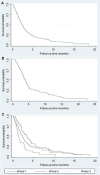Prognostic factors in ALS: different approaches to the same problem
- PMID: 40541245
- PMCID: PMC12180952
- DOI: 10.1055/s-0045-1809407
Prognostic factors in ALS: different approaches to the same problem
Abstract
The natural history of amyotrophic lateral sclerosis (ALS), the prognoses, and the survival times are fields of considerable interest that are scarcely studied in South American countries.To describe the survival of a representative cohort of Uruguayan ALS patients, and to identify covariates associated with survival using different analyses.Survival was assessed using the Kaplan-Meier method. Different Cox proportional hazards functions were used to identify independent prognostic predictors since the diagnosis: classic, stratified, and truncated.We included 166 definite and probable ALS patients. The median follow-up was of 13.6 years. An analysis was performed according to the recruitment groups: prevalent, exhaustive incident, and non-exhaustive incident cases. The median survival since the diagnosis was longer in the prevalent group (33 months) than in the exhaustive incident (22 months) and non-exhaustive incident (14 months) groups. The median survival time of the entire cohort from onset to death was 37 months and 23 months from the diagnosis. Factors related to survival from diagnosis to death were: age at onset, bulbar region onset, clinical form, and progression rate.The present study described the role of clinical and demographic factors in ALS survival in the Uruguayan population and shed light on differences involving survival models and the temporal bias produced by the lack of precision in determining the onset of the disease.
The Author(s). This is an open access article published by Thieme under the terms of the Creative Commons Attribution 4.0 International License, permitting copying and reproduction so long as the original work is given appropriate credit (https://creativecommons.org/licenses/by/4.0/).
Conflict of interest statement
The authors have no conflict of interest to declare.
Figures


Similar articles
-
Mechanical ventilation for amyotrophic lateral sclerosis/motor neuron disease.Cochrane Database Syst Rev. 2017 Oct 6;10(10):CD004427. doi: 10.1002/14651858.CD004427.pub4. Cochrane Database Syst Rev. 2017. PMID: 28982219 Free PMC article.
-
Mechanical ventilation for amyotrophic lateral sclerosis/motor neuron disease.Cochrane Database Syst Rev. 2013 Mar 28;(3):CD004427. doi: 10.1002/14651858.CD004427.pub3. Cochrane Database Syst Rev. 2013. Update in: Cochrane Database Syst Rev. 2017 Oct 06;10:CD004427. doi: 10.1002/14651858.CD004427.pub4. PMID: 23543531 Updated.
-
Artificial intelligence models using F-wave responses predict amyotrophic lateral sclerosis.Brain. 2025 Jul 7;148(7):2320-2330. doi: 10.1093/brain/awaf014. Brain. 2025. PMID: 39820267 Free PMC article.
-
Gamma aminobutyric acid (GABA) modulators for amyotrophic lateral sclerosis/motor neuron disease.Cochrane Database Syst Rev. 2017 Jan 9;1(1):CD006049. doi: 10.1002/14651858.CD006049.pub2. Cochrane Database Syst Rev. 2017. PMID: 28067943 Free PMC article.
-
Comparison of Two Modern Survival Prediction Tools, SORG-MLA and METSSS, in Patients With Symptomatic Long-bone Metastases Who Underwent Local Treatment With Surgery Followed by Radiotherapy and With Radiotherapy Alone.Clin Orthop Relat Res. 2024 Dec 1;482(12):2193-2208. doi: 10.1097/CORR.0000000000003185. Epub 2024 Jul 23. Clin Orthop Relat Res. 2024. PMID: 39051924
References
MeSH terms
LinkOut - more resources
Full Text Sources
Medical
Miscellaneous

